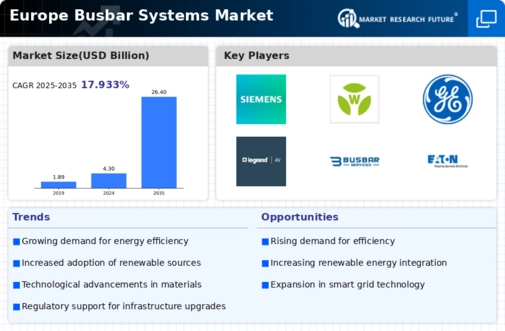Shift Towards Renewable Energy Sources
The transition to renewable energy sources in Europe is significantly influencing the busbar systems market. As countries aim to meet their renewable energy targets, the integration of solar, wind, and other renewable sources into the grid is becoming essential. Busbar systems play a crucial role in facilitating this integration by providing efficient and reliable connections between various energy sources and the grid. The European Union has set ambitious goals, aiming for at least 32% of its energy to come from renewable sources by 2030. This shift is likely to increase the demand for advanced busbar systems that can handle the variability and complexity of renewable energy inputs, thus driving market growth.
Growing Focus on Smart Grid Technologies
The increasing emphasis on smart grid technologies in Europe is reshaping the busbar systems market. Smart grids enhance the efficiency and reliability of electricity distribution, and busbar systems are integral to their operation. These systems facilitate the seamless integration of various energy sources and improve the overall management of electrical loads. With investments in smart grid infrastructure projected to reach €100 billion by 2025, the demand for innovative busbar solutions is expected to rise. This trend indicates a shift towards more intelligent and automated power distribution systems, which could lead to enhanced operational efficiency and reduced energy losses.
Enhanced Safety and Reliability Standards
The busbar systems market is experiencing a shift towards enhanced safety and reliability standards, driven by regulatory changes and industry best practices. As electrical systems become more complex, the need for robust safety measures is paramount. European regulations are increasingly mandating higher safety standards for electrical installations, which directly impacts the design and implementation of busbar systems. This trend is likely to lead to increased investments in high-quality materials and innovative designs that ensure compliance with safety regulations. Consequently, manufacturers that prioritize safety and reliability in their busbar systems are expected to gain a competitive edge in the market.
Rising Industrialization and Manufacturing Activities
The resurgence of industrialization in Europe is contributing to the growth of the busbar systems market. As manufacturing activities expand, the need for efficient power distribution within industrial facilities becomes increasingly critical. Busbar systems offer a compact and reliable solution for managing electrical loads in manufacturing environments. The European manufacturing sector is projected to grow by approximately 3% annually, creating a substantial demand for advanced electrical distribution systems. This growth is likely to drive investments in busbar technology, as industries seek to optimize their energy consumption and improve operational efficiency.
Increasing Urbanization and Infrastructure Development
The rapid urbanization across Europe is driving the demand for efficient power distribution systems, including busbar systems. As cities expand, the need for robust electrical infrastructure becomes paramount. The busbar systems market is likely to benefit from this trend, as urban areas require reliable and compact solutions for power distribution. According to recent estimates, urban areas in Europe are expected to grow by approximately 10% by 2030, necessitating enhanced electrical systems. This growth presents opportunities for manufacturers to innovate and provide solutions that meet the increasing energy demands of urban populations. Furthermore, the integration of busbar systems in new construction projects is becoming a standard practice, further propelling market growth.


















Leave a Comment